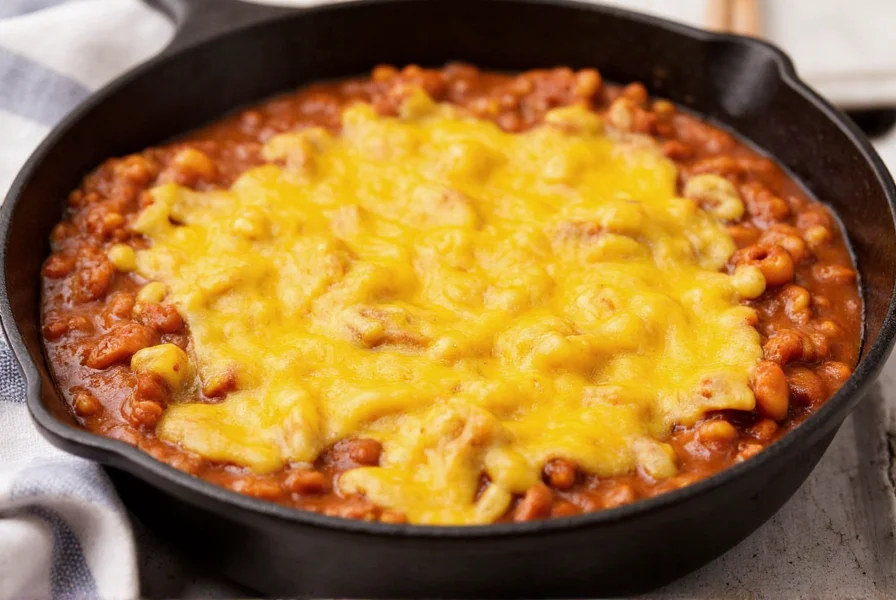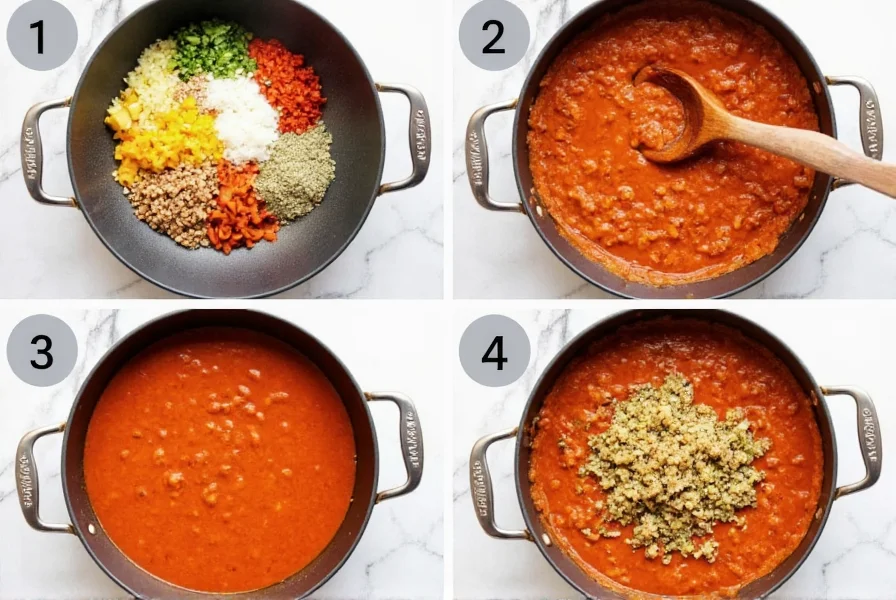The definitive classic chili mac recipe combines tender elbow macaroni with a rich, meaty chili sauce made from ground beef, kidney beans, tomatoes, and warming spices. This authentic version requires 1 pound ground beef, 2 cups cooked macaroni, 1 (15oz) can kidney beans, 1 (28oz) can crushed tomatoes, 1 onion, 2 cloves garlic, 2 tbsp chili powder, 1 tsp cumin, and salt to taste. Total preparation and cooking time is 30 minutes, serving 4-6 people. This beloved American comfort food dish originated in the early 20th century as a hearty, economical meal combining two pantry staples: chili con carne and macaroni.
The History of Classic Chili Mac
Chili macaroni, commonly known as chili mac, emerged during the Great Depression as a practical way to stretch limited ingredients. Food historians trace its origins to the 1930s when home cooks combined affordable ground beef, canned tomatoes, beans, and pasta to create satisfying meals. The dish gained widespread popularity through military mess halls during World War II and became a staple in American households by the 1950s. Unlike traditional Texas-style chili which contains no beans, classic chili mac incorporates kidney beans for added texture and nutrition, making it a complete one-dish meal.
Why This Classic Chili Mac Recipe Works
This authentic recipe balances rich meatiness with comforting pasta elements while maintaining the proper chili-to-macaroni ratio that defines the dish. The key to success lies in the layering of flavors: browning the beef properly creates fond (those delicious browned bits), sautéing onions and garlic releases their natural sugars, and allowing the chili to simmer briefly with the macaroni helps the pasta absorb the flavorful sauce without becoming mushy.
| Prep Time | Cook Time | Total Time | Servings |
|---|---|---|---|
| 10 minutes | 20 minutes | 30 minutes | 4-6 |
Ingredient Breakdown: Quality Matters
The magic of a perfect classic chili mac recipe lies in selecting quality ingredients that work harmoniously:
- Ground beef (80/20 lean-to-fat ratio): Provides rich flavor and proper texture. Avoid extra-lean varieties which can dry out.
- Elbow macaroni: Cook al dente before adding to chili. Small shells work as excellent alternative for better sauce adherence.
- Kidney beans: Drain and rinse thoroughly to remove excess sodium and the canning liquid that can affect texture.
- Crushed tomatoes: Preferably San Marzano variety for balanced sweetness and acidity.
- Chili powder blend: Use a quality commercial blend rather than pure cayenne for complex flavor.

Step-by-Step Classic Chili Mac Instructions
- Brown 1 pound ground beef in large skillet over medium-high heat, breaking into small crumbles. Drain excess fat if desired.
- Add 1 diced onion and 2 minced garlic cloves, cooking until translucent (about 5 minutes).
- Stir in 2 tablespoons chili powder, 1 teaspoon cumin, and 1/2 teaspoon paprika. Cook for 1 minute to toast spices.
- Add 1 (28oz) can crushed tomatoes, 1 (15oz) can drained kidney beans, and 1/2 cup water. Simmer 10 minutes.
- Meanwhile, cook 2 cups dry elbow macaroni according to package directions, but reduce cooking time by 2 minutes.
- Drain macaroni and add to chili mixture. Stir gently and simmer 3-4 minutes until pasta reaches perfect al dente texture and absorbs some sauce.
- Season with salt to taste and serve immediately.
Common Mistakes to Avoid in Your Chili Mac
Even experienced cooks can stumble when preparing this seemingly simple dish. Here's what to watch for:
- Overcooking the pasta: Cook macaroni separately and slightly underdone, as it continues cooking in the chili.
- Adding cold pasta to hot chili: This sudden temperature change can make pasta gummy. Drain well and add immediately.
- Using pre-seasoned meat: Many "taco seasoned" ground beef products contain fillers that alter texture and flavor.
- Skipping the spice blooming step: Toasting spices in the meat fat unlocks their full flavor potential.
- Adding cheese directly to the pot: Melt cheese on individual servings to maintain optimal texture.
Serving Suggestions for Authentic Chili Mac
Serve classic chili mac immediately while hot, with these traditional accompaniments:
- Shredded cheddar cheese melted on top
- Freshly chopped red onions for brightness
- Sliced jalapeños for heat lovers
- Cornbread or saltine crackers on the side
- Cold beer or iced tea as beverage pairings
Storage and Reheating Tips
While chili mac is best enjoyed fresh, leftovers can be stored properly:
- Cool completely before storing in airtight containers
- Refrigerate for up to 4 days or freeze for up to 3 months
- Reheat on stove with a splash of water or broth to restore moisture
- Avoid microwaving without added liquid as it dries out the pasta
- Add fresh cheese after reheating for best results
Variations on the Classic Recipe
Once you've mastered the traditional version, try these popular adaptations:
- Texas-style: Omit beans for a meat-forward version closer to authentic chili con carne
- White chili mac: Use ground turkey, white beans, and green chilies with a cream-based sauce
- Vegan chili mac: Substitute plant-based meat, vegetable broth, and nutritional yeast for cheese
- Smoky chipotle version: Add 1-2 minced chipotle peppers in adobo sauce for depth
- Cheesy baked version: Transfer to baking dish, top with extra cheese, and broil until golden

Frequently Asked Questions
Can I make classic chili mac in a slow cooker?
Yes, you can adapt this classic chili mac recipe for a slow cooker. Brown the beef and sauté vegetables first, then transfer to slow cooker with all ingredients except the cooked macaroni. Cook on low for 4-6 hours, then stir in cooked pasta during the last 30 minutes to prevent mushiness. This slow cooker method develops deeper flavors while maintaining proper pasta texture.
What's the difference between chili mac and regular chili?
The primary difference in this classic chili mac recipe is the addition of cooked macaroni pasta. Traditional chili con carne typically contains meat, tomatoes, beans, and spices but no pasta. Chili mac specifically incorporates elbow macaroni or similar small pasta shapes, creating a heartier, more substantial one-dish meal that combines elements of both chili and macaroni dishes.
How can I make my chili mac less spicy?
To reduce spiciness in your classic chili mac recipe, decrease the chili powder to 1 tablespoon and omit any additional hot spices. Add 1 tablespoon of sugar or honey to balance acidity, or stir in 1/4 cup of sour cream or plain yogurt at the end. Dairy products naturally counteract capsaicin, the compound responsible for heat in chili peppers, making your dish more approachable for sensitive palates.
Can I use different types of beans in classic chili mac?
Absolutely. While kidney beans are traditional in classic chili mac recipes, you can substitute pinto beans, black beans, or a three-bean mix. Each variety brings different texture and flavor profiles—pinto beans are creamier, black beans hold their shape better, and cannellini beans offer a milder flavor. Drain and rinse any canned beans thoroughly to remove excess sodium and the starchy liquid that can affect sauce consistency.
Why does my chili mac turn out watery?
Watery chili mac typically results from adding too much liquid or not allowing proper reduction. To fix this in your classic chili mac recipe, simmer uncovered for 5-10 minutes to evaporate excess moisture. Alternatively, create a slurry with 1 tablespoon cornstarch mixed with 2 tablespoons cold water, then stir into the chili and cook for 2 minutes until thickened. Remember that pasta continues absorbing liquid as it sits, so your chili mac will thicken slightly when resting before serving.











 浙公网安备
33010002000092号
浙公网安备
33010002000092号 浙B2-20120091-4
浙B2-20120091-4